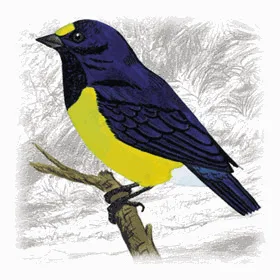 White-vented Euphonia White-vented Euphonia (Euphonia minuta) [order] PASSERIFORMES | [family] Fringillidae | [latin] Euphonia minuta | [UK] White-vented Euphonia | [FR] Petit Euphone | [DE] Weissbauch-Organist | [ES] Fruterito Menudito | [NL] Witbuikorganist Subspecies
Physical charateristicsFemales are readily distinguishable by a broad band of dull yellowish crossing the breast and forming a marked contrast to the grayish throat and abdomen. The male has a bright yellow forehead, is all dark blue above with a blackish chest and bright yellow underparts. Listen to the sound of White-vented Euphonia [audio:http://www.aviflevoland.nl/sounddb/W/White-vented Euphonia.mp3]
RangeLatin America : Mexico to Ecuador, Guianas to Central Bolivia HabitatIts natural habitats are subtropical or tropical moist lowland forests and heavily degraded former forest. This bird lives in pairs or in small groups, sometimes following mixed-species flocks in the canopies and along the edges of rain forests. It is difficult to observe because it spends most of its time perched high up in the canopy. ReproductionBuilds a ball of moss with a side entrance 3-20 meters above ground. Clutch size is 3-5 eggs. Feeding habitsFeeds alone or in small groups for fruit and berries high up in the canopy. ConservationThis species has an extremely large range, and hence does not approach the thresholds for Vulnerable under the range size criterion (Extent of Occurrence <20,000 km2 combined with a declining or fluctuating range size, habitat extent/quality, or population size and a small number of locations or severe fragmentation). The population trend appears to be stable, and hence the species does not approach the thresholds for Vulnerable under the population trend criterion (>30% decline over ten years or three generations). The population size is very large, and hence does not approach the thresholds for Vulnerable under the population size criterion (<10,000 mature individuals with a continuing decline estimated to be >10% in ten years or three generations, or with a specified population structure). For these reasons the species is evaluated as Least Concern.  MigrationSedentary throughout range Distribution map |
]]>
